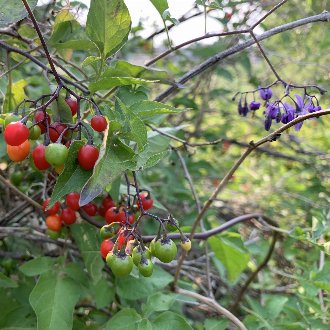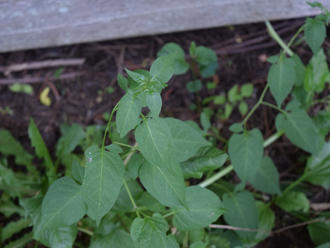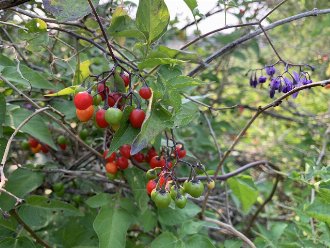Bittersweet Nightshade (Solanum dulcamara L.)
Also known as climbing nightshade, bittersweet.
↑Summary
A toxic perennial vine or subshrub native to Eurasia and widely introduced in North America, invasive in the northeast.
↑Range - Expand
| Legend | Color |
| Introduced | |
| Introduced or Not Present |
This tentative map is based on our own research. It may have limited data on Canada and/or Mexico, and there is some subjectivity in our assignment of plants as introduced vs. expanded. Read more in this blog post.
Although this plant occurs somewhere in each of these regions, it may only occur in a small part of some or all of them.
↑Description & Identification
An perennial vine, herbaceous to semi-woody, climbing by draping itself. Alternate leaves have smooth margins and are irregularly lobed at the base, usually with one broad central lobe taking up much of the leaf, and two small side lobes at the base. Occasionally, asymmetrically lobed, or with multiple lobes at the base. 5-petaled flowers purple, with yellow anthers fused into a cone. Fruit begins green, turning through yellow and orange to a bright red when ripe.
↑Habitat
In North America, this species occurs in a wide range of habitats, but is uncommon to scattered in less ideal habitats. It becomes more aggressive and dominant in the north of its introduced range, including New England through the upper Midwest, and in moist habitats. Natural habitats include openings and edges in bottomland woods, marshes, and bogs; it is less common in upland habitats, where it still favors openings and edges. It is significantly more likely to occur in anthropogenic habitats, including fencerows, weedy garden margins, and small forest fragments.
This species prefers partial sun, loamy soil, and moist to mesic conditions, but tolerates a wide range of conditions including full sun to varying levels of shade, and a wide range of soil textures. It prefers soils high in nitrogen and where litter has a low carbon-to-nitrogen ratio. It tolerates temporary flooding so long as it is infrequent; it cannot survive in frequently or regularly flooded habitats. It often prefers habitat with temporary flooding during the dormant season. However, it can also survive in dry habitats. It does best in habitats where soil fertility, moisture, and levels of disturbance are spotty and inconsistent, so it can establish in an exposed spot with good soil conditions and then sprawl to reach greater light and/or take advantage of changing conditions.
Humans have increased the habitat for this species through increased disturbance of areas with moist, loamy soils, through the creation of more edge habitat, and through fencerow maintenance, particularly along chain-linked fences that have a structure that this species readily climbs. The inconsistent and/or patchy maintenance of landscapes also favors this plant.
↑Life Cycle
This species is a perennial, semi-woody vine that has some capacity to become shrublike or semi-erect.
Seeds germinate in a wide variety of conditions, typically triggered by temperatures, leading to germination between March and April, with some germination throughout the rest of the growing season. Because seeds germinate in a wide range of conditions, including on unsuitable sites, seedling mortality is extremely high. Seedling mortality is frequently caused by drought or heavy shading, but less commonly by herbivory, as this plant quickly produces toxins making it unattractive to most herbivores.
Growth habit varies widely based on habitat structure; on open sites it trails along the ground, but in the presence of competing vegetation it climbs somewhat. However, its climbing mechanism is limited, lacking tendrils, and having a stem with only slight twining ability. As such, it can only climb stems or structures with a diameter of 3-4mm; smaller structures typically cannot support its weight, but it cannot effectively wrap around larger ones. Once it has climbed to a particular height, it supports its weight by branches that hold it in place.
First year plants typically remain small, and this species only reaches its maximum size when better-established. Maximum height varies from barely above the ground on open sites, to climbing to 6 ft or rarely to 12 ft when adequate structure is found. Vines are typically 2-10 ft in length, but occasionally grow longer, up to 23 feet.
Flowers begin forming during summer; the bloom period is long, lasting 2-3 months, and typically fruits begin forming and even mature and are consumed by animals, even as the plant is still forming new flowers. Seeds are primarily distributed by animals consuming the fruit; typically fruits are consumed mostly by birds, but mammals also play a role. Seeds are viable immediately after dispersal, and some germinate immediately after passing through the gut of an animal. The remainder of seeds mostly germinate in the following spring. Although experiments have shown that seeds can remain viable for over a year, the tendency of seeds to germinate readily likely means that this species does not form a persistent seed bank. Seeds do not even require light to germinate, and can germinate in complete darkness.
This plant can reproduce vegetatively by two distinct means: established plants form rhizomes that produce new sprouts on favorable sites. Less commonly, sprawling stems that reach the ground can root at nodes, forming a new root system and eventually new stems.
The base of the stem typically becomes woody, with woody perennial parts sometimes extending a few feet off the ground, but never extending to include the full extent of the plant. Rhizomes also become woody.
↑Control
Controlling this plant can vary from easy to challenging, depending on the site and the age of the plants. Young plants are easily removed and less likely to resprout from small pieces of root. Established plants, however, readily and vigorously resprout from rhizomes.
When roots can be easily removed, it is easily controlled by uprooting, which is best done when soil is moist, such as directly following rain. Digging is least effective in dry and/or rocky soils, especially with older plants.
In most situations, this species grows closely with other vegetation, often climbing native vegetation, and in these circumstances, herbicide use can do more harm than good by killing other vegetation. However, herbicide can be effective when this species forms large monocultures, especially when it is applied during dry periods where the herbicide is unlikely to wash off, and when it is not as practical to dig out the roots. In some circumstances, the foliage of this species can emerge earlier than or persist longer than competing vegetation, so it may be possible to apply herbicide without harming other vegetation by timing the application when other plants are dormant. If herbicide is to be effective, stems must not be cut after the treatment.
Regardless of the removal method used, it is important to establish competing ground-level vegetation to prevent reestablishment. Competition can both hinder reestablishment of seedlings from nearby populations, and resprouts.
↑Notes
Most of the plant is highly toxic to humans, especially the foliage and unripe fruit, although ripe fruit tend to be less toxic. Although the fruit tend to be are very bitter, leading most people to spit them out if tasted, they are toxic enough that even eating a small amount of them can be dangerous to children, and the appealing appearance of the ripe fruit magnifies their danger.
↑Links & External Resources
• Climbing Nightshade | Fire Effects Information System (FEIS) (About This Site)
• Solanum dulcamara (Bittersweet Nightshade) | Illinois Wildflowers (About This Site)
• Solanum dulcamara (Bittersweet Nightshade) | USDA PLANTS Database (About This Site)
• Solanum dulcamara | Go Botany (About This Site)
• Bitter Nightshade | Virginia Tech Dendrology Factsheets (About This Site)
• Solanum dulcamara | Biota of North America Project (BONAP) (About This Site)
• Solanum dulcamara | NatureServe Explorer (About This Site)
• Solanum dulcamara | Missouri Plants (About This Site)
• Climbing Nightshade | Maryland Biodiversity Project (About This Site)
• Solanum dulcamara (Bittersweet Nightshade) | Minnesota Wildflowers (About This Site)
• Solanum dulcamara L. (Bittersweet, Climbing Nightshade) | Digital Atlas of the Virginia Flora (About This Site)





